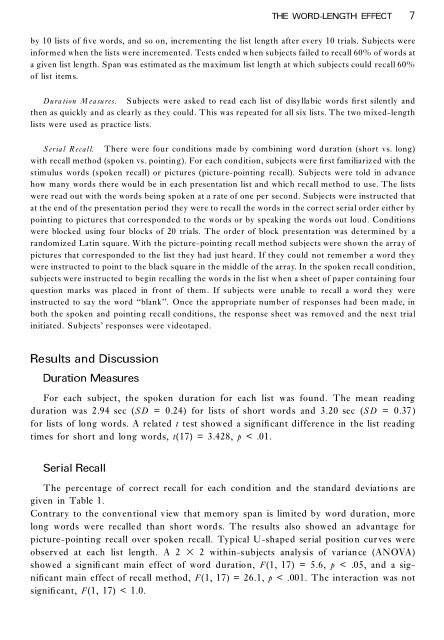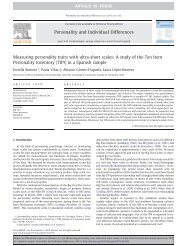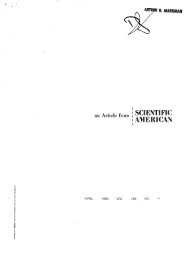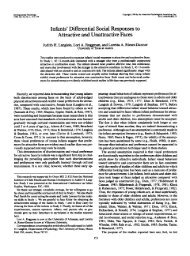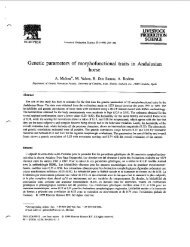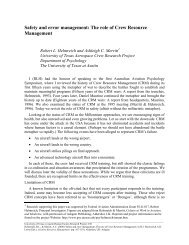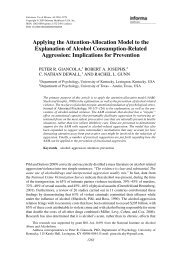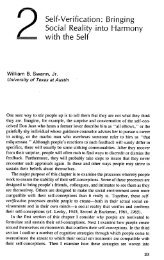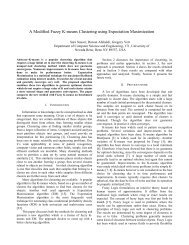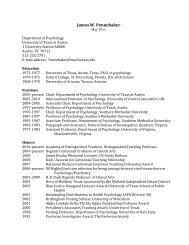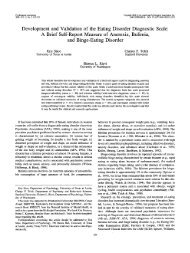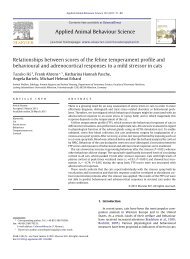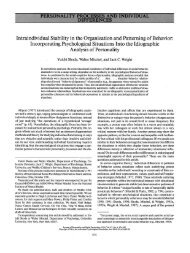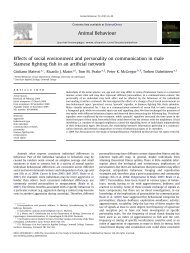The Word-Length Effect and Disyllabic Words (Lovatt
The Word-Length Effect and Disyllabic Words (Lovatt
The Word-Length Effect and Disyllabic Words (Lovatt
Create successful ePaper yourself
Turn your PDF publications into a flip-book with our unique Google optimized e-Paper software.
THE WORD-LENGTH EFFECT 7<br />
by 10 lists of ®ve words, <strong>and</strong> so on, incrementing the list length after every 10 trials. Subjects were<br />
informed when the lists were incremented. Tests ended when subjects failed to recall 60% of words at<br />
a given list length. Span was estimated as the maximum list length at which subjects could recall 60%<br />
of list items.<br />
Dura tion M easures. Subjects were asked to read each list of disyllabic words ®rst silently <strong>and</strong><br />
then as quickly <strong>and</strong> as clearly as they could. This was repeated for all six lists. <strong>The</strong> two mixed-length<br />
lists were used as practice lists.<br />
Serial Recall. <strong>The</strong>re were four conditions made by combining word duration (short vs. long)<br />
with recall method (spoken vs. pointing). For each condition, subjects were ®rst familiarized with the<br />
stimulus words (spoken recall) or pictures (picture-pointing recall). Subjects were told in advance<br />
how many words there would be in each presentation list <strong>and</strong> which recall method to use. <strong>The</strong> lists<br />
were read out with the words being spoken at a rate of one per second. Subjects were instructed that<br />
at the end of the presentation period they were to recall the words in the correct serial order either by<br />
pointing to pictures that corresponded to the words or by speaking the words out loud. Conditions<br />
were blocked using four blocks of 20 trials. <strong>The</strong> order of block presentation was determined by a<br />
r<strong>and</strong>omized Latin square. With the picture-pointing recall method subjects were shown the array of<br />
pictures that corresponded to the list they had just heard. If they could not remember a word they<br />
were instructed to point to the black square in the middle of the array. In the spoken recall condition,<br />
subjects were instructed to begin recalling the words in the list when a sheet of paper containing four<br />
question marks was placed in front of them. If subjects were unable to recall a word they were<br />
instructed to say the word ``blank’’. Once the appropriate number of responses had been made, in<br />
both the spoken <strong>and</strong> pointing recall conditions, the response sheet was removed <strong>and</strong> the next trial<br />
initiated. Subjects’ responses were videotaped.<br />
Results <strong>and</strong> Discussion<br />
Duration Measures<br />
For each subject, the spoken duration for each list was found. <strong>The</strong> mean reading<br />
duration was 2.94 sec (SD = 0.24) for lists of short words <strong>and</strong> 3.20 sec (SD = 0.37)<br />
for lists of long words. A related t test showed a signi®cant difference in the list reading<br />
times for short <strong>and</strong> long words, t(17) = 3.428, p < .01.<br />
Serial Recall<br />
<strong>The</strong> percentage of correct recall for each condition <strong>and</strong> the st<strong>and</strong>ard deviations are<br />
given in Table 1.<br />
Contrary to the conventional view that memory span is limited by word duration, more<br />
long words were recalled than short words. <strong>The</strong> results also showed an advantage for<br />
picture-pointing recall over spoken recall. Typical U-shaped serial position curves were<br />
observed at each list length. A 2 3 2 within-subjects analysis of variance (ANOVA)<br />
showed a signi® cant main effect of word duration, F(1, 17) = 5.6, p < .05, <strong>and</strong> a signi®cant<br />
main effect of recall method, F(1, 17) = 26.1, p < .001. <strong>The</strong> interaction was not<br />
signi®cant, F(1, 17) < 1.0.


